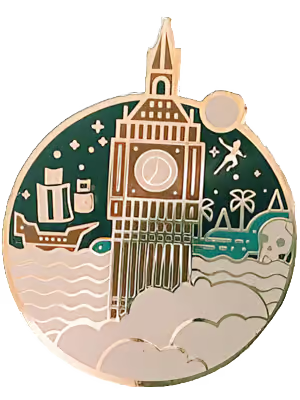
There’s a peculiar kind of conversation one has with a city that only reveals itself when you slow down—when you don’t chase the landmarks but let your feet and eyes wander freely.
London carries its history like a royal robe—intricate, grand, draped in the weight of postcard moments. But beyond the towering presence of Big Ben and the crown jewel of Tower Bridge, there’s another city, weathered, restless. It lingers in the hurried yet rhythmic footsteps of commuters on crowded platforms, in the way sunlight spills unexpectedly down an alley, gilding the ordinary just long enough to make you notice.
These are the moments that slip past, unremarked, yet they hold something truer, something almost fragile—the real pulse of a city exists not in its monuments, but in its breath.
The photos I share are not postcards or touristic tokens, but quiet fragments—brief exchanges between a wandering eye and a living city. What follows is less a guide and more a set of reflections—an attempt to listen to the city’s softer stories, the everyday poetries that don’t get written on postcards but stay with you long after.

The crisp morning air brushed against my face as I stepped outside the hostel door. It was the kind of cold that wakes you fully, even if your body is still catching up from a restless flight and hours in transit. It was my first morning in the UK. I couldn’t sleep. Excitement, maybe. Or just the quiet pull of a city I didn’t yet know, whispering for me to come find it. I took my time layering up, buttoning my jacket not out of coldness, but as if to brace myself for something bigger than weather: a new chapter, a new city, a new adventure.

It was September, and the light carried in itself a quiet, golden fragility—something fleeting, yet somehow eternal. The sun, often hidden behind long weeks of grey, greeted me softly that morning. It settled over the old brickwork then spilled onto the street with a tenderness that felt almost intentional.

The city stirred slowly. Shutters rattled as vendors opened their stalls; the metallic clink of a shopkeeper arranging his wares echoed faintly. Somewhere, the warm scent of fresh bread drifted from a bakery not yet open, mingling with the faint diesel tang of early delivery trucks. Back home in Saigon, mornings came alive quickly and noisily. Here, the city seemed to stretch itself out slowly, like time itself had softened at the edges.
With curiosity as my compass, I let my eyes lose themselves in the pull of uncharted corners, and my feet find their own sense of direction. Like a bee drawn to the golden honeyed morning light, I turned into side streets, where narrow alleys felt like it might reveal something secret while the shadows of night still clung to the corners, reluctant to fade.
And then I found myself here—at the edge of this quiet alley. The wall before me, worn and softened by decades of weather, glowed gently in the morning light. A lone figure walked ahead of me, his silhouette elongated by the rising sun, stretching across the damp pavement, mirrored faintly in the puddles left by the late night’s rain.
I paused, caught by the simplicity of the moment. No rush. No noise. Just the rhythm of footsteps echoing off bricks soaked in time. It felt like I had stepped into a memory before it had even happened.
I raised my camera—and took the shot.

After weaving through hushed alleyways and sun-dappled lanes, I found myself back in Soho—London’s most delicious contradiction, where century-old pubs rub shoulders with sleek cocktail dens, their facades alive with symphony of clinking glasses, shouted gossip, and the sultry wail of saxophones bleeding through cracked-open windows. The intoxicating district wears its history like smudged eyeliner—glamorous, a little messy, yet utterly irresistible.

And that’s when I saw it.
A bold proclamation, yet perfectly suited for a music store in this electric neighbourhood. But what struck me first wasn’t its cosmic name—it was the architecture. The storefront was framed with dark red ceramic tiles, rich and earthy, worn smooth by time but still catching the light in a way that made it glow softly against the brick walls. The window panes were deep-set, surrounded by wooden trims painted in similar shade, behind which rows of vinyl sleeves, CDs and posters layered like time capsules, softly whisper the story of decades. Some of the corners were chipped, the edges worn—a quiet testimony to the passing of time.
It reminded me instantly of the movie stores I used to visit back home in Hồ Chí Minh City. Back in the early 2000s, I would frequent those little shops, all crammed floor-to-ceiling with movie posters & DVD covers. I remember the excitement of browsing through their thick catalogues, finding new, exciting films to watch just by feeling the vibes through its covers. Titles like Harry Potter lined the walls, and I’d often come back to ask the owner if the next one is released yet. There was a kind of ceremony in it: the physicality of the disk, the cover art, the act of unwrapping it, placing it into the player, waiting for the screen to load.
But over time, those rituals faded. Discs became expensive, and the internet grew faster. YouTube became my new default, a new horizon—limitless access at the click of a button. Eventually, I stopped going to the stores. Everyone did. They disappeared, one by one. The shelves emptied, the shutters came down. The digital swiftly replaced the physical, and somehow, I didn’t even notice it happening until it was already gone, like they had never existed.
Outside the shop, a man leaned against the wall, eyes cast down at his phone. He was absorbed in whatever glowed on his screen, framed by the very windows that displayed posters for analog sound. That moment struck me—a juxtaposition of eras. He, like me, was part of the new age: fast, connected, algorithm-fed. And yet he was here, seeking shelter from a familiar place that still believed in the slow magic of holding music in your hands.
The nostalgia washed over me—a bittersweet ache, softened by a sudden spark of joy.
Because this store, this safe haven of preserved culture, felt like a pocket of resistance. A place where time hadn’t fully surrendered to convenience. And the fact that it still stood here, in the heart of one of the most modern cities in the world, made me hopeful.
Hopeful that maybe not everything from the past has to vanish.
That quiet truth lingered in the air: the past may fade, but it never truly leaves. It lingers in corners like this, humming its own timeless rhythm. Waiting, patiently, for the right soul to wander in.

By the time I reached Dean Street, the morning had fully settled in—still cold, but softened by the golden syrup trickling down between the buildings. The streets were beginning to swell with the rhythm of the city—not yet crowded, but no longer empty.
So this is London, I thought. Not the stereotypical London of rain & fog, but a lived-in, quietly radiant version of it.


I caught sight of a woman—striped dress, green beret—crossing the street with effortless grace. The tilt of her hat swayed with each step; her figure softened by the golden haze, lending her an almost cinematic glow. She walked toward a pristine white building, its windows tall and proud, its doorway framed with ornamental trim, and its regal facade gleaming against the warm brick beside it. A polished Mercedes idled out front, encircled by laughter and low chatter. There was a quiet choreography to it all—graceful, composed, expensive. Perhaps it was a chic brunch spot, or a private club. I didn’t know. But I liked that I didn’t need to know. I was simply here, witnessing, observing the many ways Londoners go about their daily lives.
Just blocks away, down a narrow alley, a small sandwich bar tucked into the corner of Wardour Street came into view, with humble signage and a faded green awing. A man sat out front, basking in the last of the sun with his sunglasses on, one leg crossed over the other, sipping coffee like he had all the time in the world. Was he watching the people or just sitting in the warmth? Maybe both. This place had none of the elegance of the former, but it had a grounded intimacy that felt just as vital.
I hadn’t noticed it while I was there. But now, in hindsight, I was struck by the quiet duality they represented. Two versions of London, existing not in opposition, but in parallel. No dramatic division, no clear boundary. Just subtle textures of lives unfolding differently.
Yet, that contrast didn’t make the city feel disjointed. If anything, it made London feel more whole. It’s not a city with one rhythm, but many—and they all coexist, brushing past each other on these narrow streets. And somehow, that patchwork—messy, elegant, ordinary, extraordinary—is what made it feel alive.
And here I was, in between—just a quiet observer with a camera in hand, learning how this city breathes. This was just the beginning, and already, London was showing me how many ways there are to be.

Not all those who wander are lost.
— J.R.R. Tolkien







I’ve always found London’s Underground stations to be like gateways into the character of each neighborhood—each stop wearing its own little costume, tailored to reflect the history and temperament of the streets above. South Kensington, for instance, greets you with an ornate canopy held up by stout, cream-painted columns, their flaking surfaces hinting at a century and a half of rain, soot, and quiet endurance. Above, a wrought-iron crest stretches across the entrance, its gilded lettering still catching stray shafts of sunlight that filter through the aging glass roof. Just to the sides, the words “Metropolitan and District Railways” march in a more formal serif, evoking images of Victorian engineers and the grand ambition of a city that once dreamed of tunneling its future beneath its own feet.
Every etched letter and every wrought-iron flourish feels like a relic belonged to an era of top hats and handwritten timetables. A modest plaque marked “c.1868” clings on one of the Tuscan columns, a time capsule that anchors the station in history, of aristocrats strolling along Exhibition Road, of carriage wheels cutting soft grooves into the earth, of steam engines roaring awake beneath the city’s refined surface.
Stations don’t just move people—they hold memories. And as I descend the stairs into the tunnels below, I’m reminded of a saying I once heard:
Old doesn’t mean obsolete.
Sometimes, it’s what holds the soul of a place.
Những gì cũ kỹ chưa chắc đã lỗi thời—đôi khi là thứ lưu giữ lại linh hồn của nơi chốn ấy.

I don’t remember what song he was playing.
That stretch of tunnel beneath South Kensington isn’t meant for memories. It’s a corridor—a space between destinations, built for passing through, not pausing. A place designed for forgetting. Yet here he was, casually seated against the tiled wall, folding chair just slightly crooked, clarinet resting in his hands like an old dear friend.
His music wasn’t loud. It didn’t ask for much attention. It simply existed—as ambience, as background noise—curling into corners, lifting beneath the tired fluorescents, mingling with the footsteps and damp silence of the underpass.

I lingered a bit—drawn in by his solitary figure.
Maybe it was the lighting—how it pooled softly around him, like a spotlight drawn by accident. Maybe it was the red of his cap, striking and defiance against the beige washed-out brick. Or maybe it was something quieter: the way he seemed unbothered for the hurry of the world, lost in his own rhythm, carving out a pocket of time where nothing moved but the air between his fingers and the sound of his clarinet.
For just a moment, I stepped outside London’s relentless rhythm and into his slower world. A borrowed stillness, carved out not with silence—but with song.
There was no crowd. No applause. Just a few commuters passing, eyes locked forward, earbuds in, each carrying their own soundtrack, never hearing his.
But I did.
And sometimes, that’s all a song needs. One listener.

The platform at Tottenham Court Road wasn’t just a stop—it was a kaleidoscope etched in concrete form. The mosaic tiles roared in shades of red, gold, turquoise, and blue, each square a brushstroke in an uncontainable mural. It was a wall that refused silence, a riot of geometry, rhythm and imagination—a place where even the advertisements fought for your gaze, as if the station itself had declared long ago that dullness had no place beneath the city.
And then came the different kind of boldness.

She stepped into the frame with the kind of presence that doesn’t ask for attention but takes it all the same. The red beanie was the first thing I noticed—crisp, clean, vibrant—like a period at the end of a line, or the stroke of vermilion in a gallery of noise. It caught the station light just enough to glow against her dark, flowing hair. Her black jacket, cropped and confident, mirrored her boots that struck the tiles in sharp rhythm—measured, deliberate. And between them, the red dress: vibrant, unfazed. It didn’t scream, but it didn’t need to. Its confidence came not from volume, but clarity.
The whole station felt alive, yes—but she felt composed. She didn’t rush. She didn’t waver. She was the contrast: poised within chaos, matte against gloss, steady within a blur of movement. All around her, people moved at different rhythms—some rushed, others drifted—but she held her own tempo, steady, almost cinematic.
There was nothing hesitant about her presence. Among the colorful & unapologetic mural, she looked like she belonged exactly where she was. Boldness doesn’t always have to be loud. Sometimes, it’s simply a woman in red, walking through a mosaic corridor.


I stood on the platform, quietly observing—peering into the carriage through its smudged window, watching a moment of life compressed into a metal box hurtling toward somewhere else.
A quiet choreography of London life: bodies swaying to the rhythm of the rails, minds adrift elsewhere. They stood shoulder to shoulder, yet each was enclosed in their own private space. In that strange intimacy of public transport, mo one looked up. No eyes met one another’s. The woman near the pole clutched her phone like a compass, eyes fixed downward, her earbuds sealing her off from the hushed chorus of the carriage. Beside her, another flipped through a magazine with focused intent, as if the pages might unfold into somewhere softer, somewhere far from fluorescent lighting and stop announcements. Their postures all carried something unsaid: fatigue, purpose, repetition.
I wondered if they saw one another at all, or if they’d learned long ago how to draw quiet borders around themselves. It’s strange—the closeness we learn to endure in cities like this. The nearness of bodies with the distance of minds. Nobody speaks, and yet you can almost hear the chorus of inner monologues: groceries to remember, emails unanswered, someone they miss, someone they don’t.
The train didn’t wait long. It never does. With a soft hiss and a lurch, it closed its doors and pulled away, taking all those lives, those stories along with it.
I watched, until the carriage blurred and disappeared into the tunnel. I pocketed my camera, let the brief silence settle.
My train would be here in two minutes.

Life begins at the end of your comfort zone.
— Neale Donald Walsch






There are photographs I took that feel less like frozen moments in time and more like still frames pulled from a film I haven’t seen but somehow recognize. This was one of them.
He stood there at the crossroad of Great Windmill Street, just long enough for me to raise the camera. His back was turned, his stillness deliberate, as the cab drifted past like a tracking shot. Behind him, the crowd blurred into shadows of movement—extras in a scene they didn’t realize they were in. But him—he was fixed. Composed. Waiting. As if the city had paused just for him.
The light found him—not broadly, not by accident—but intentional like a spotlight called in on cue. It caught the silver in his hair and set it aglow—like frost burning under autumn sun, against the city’s cold exhale. For a short breath, the world dimmed everything else, as though the street had been staged, leaving only him in focus.
And I couldn’t help but imagine him, the protagonist in this fictional movie.
Not the grand, heroic type, but in the way some characters carry entire stories in their silence. Maybe he had just returned to the city after years away, pulled back by some unresolved note from the past. Or maybe, in the next frame, he would step into a building and alter a life—unaware that this intersection, this pause, is the quiet hinge of something irreversible.
I love photos like this. They don’t just capture a pure memory; they invoke my imaginations, open a door to a film that doesn’t exist, one that flickers to life in the corners of my mind if I oh so want to indulge in it. They remind me that every stranger—every person moves through a script I’ll never read, that every street corner might be the climax of a story I’ve only just entered.
And sometimes, it’s enough to catch that single frame—when the city, with all its noise and sprawl, grants someone a brief moment of limelight. Not every scene demands dialogue. Some are meant to unfold in silence.

Sometimes the world composes itself so impeccably, you feel less like a photographer and more like a director stepping onto a romantic film set that’s already been lit, blocked, and cued to perfection.
The architecture becomes the stage: windows, brickwork, doorways—each element strictly carves the façade into a rigid grid of rectangles. There, just off-center, two figures break the rigorous rhythm—locked in a gentle embrace, shielded from curious eyes, nestled against the cathedral of red brick.
Their presence softens the scene. A moment of warmth against stiff geometry. Flesh and breath interrupting brick and paint. Even their clothing—dark, simple—stands out against the crimson wall behind them, like a velvet curtain drawn closed after the final act of a dramatic play. A private act performed in public, but for no audience. Everything around them feels composed, balanced and intentional. And yet, it’s their presence alone—tender, unrehearsed—that gives the composition its pulse and brings the frame to life.
Where I grew up, public affection was quieter, often discreet—not out of shame, but shaped by the rhythm of our reserved culture. We kept closeness tucked into subtler gestures. So to see it here, so open, so unapologetically placed at the center of a scene—feels both foreign and free. In London, maybe there’s more space—for breath, for distance, for love to live unhidden.
Afterall, intimacy need not be loud to be real.


The sun broke through the clouds just as the clock struck 4:40. It always feels staged when nature does that—like the sky is trying to remind us that even monuments need moments of grace.
I stood across the Thames and watched the light fall like a slow revelation over Big Ben. Tourists were doing what tourists do, and I was no different. Really, who came to London and doesn’t feel compelled to capture it? But I wanted more than just a postcard; I wanted a story hidden within the scene. And that’s when my gaze settled on him—a man leaning against the rail, his entire being oriented toward the tower.
He wasn’t capturing the moment; he was immersed in it. No phone, no conversation, just a silent communion with the tower. He was an anchor point in the endless flow, a comma in the city’s long, run-on sentence.
There’s something oddly comforting in knowing that even the busiest places allow room for quiet. That a person can find a pocket of stillness in the churn. And maybe that’s all any of us are really looking for—not an answer, not a sign—just a moment where we can finally breathe and not be expected to move.
I had been walking the river’s edge for a while, chasing the winking light like a restless cat—checking angles, gauging clouds, mapping in my head where the sun would settle against Big Ben’s stone ribs. I was so intent on horizons that I almost missed what was right beside me: a low, unassuming wall, pale and softly glowing as if it had been kissed by every sunset that ever was.
Up close, I saw why it glowed. The surface was covered—heart after heart after heart—each one hand-drawn, imperfect, personal. At first I thought it was street art, some optimistic project to brighten the embankment. Then the names came into focus, the dates, the tiny messages squeezed into red shapes no larger than a palm. A memorial, a public mural stretching on and on, an unbroken river of grief and love that has no beginning and no real end.

I hadn’t known the wall existed. The surprise of it felt like a quiet knock in the chest—an invitation to pause. I stood there, slowly examining the mural with quiet reflection, letting the weight of all those hearts settle in. The air felt thick, as if the Thames were holding its breath with me.
It’s strange to feel the sun warming my face while reading messages written in loss. As if life insists on continuing whether we’re ready or not. The morning moves forward. Joggers pass, footsteps echo. But the wall stays. The hearts stay.
A baby stroller rested against the wall, its owner momentarily elsewhere. It struck me as the gentlest contradiction: a vessel meant for beginnings placed before a record of endings, how life and loss are always sharing the same pavement—we’re just not usually asked to look at both in the same frame.
For a second, I think about how we memorialize pain—how we try to give shape to the formless. In Vietnam, grief is often kept indoors, in incense smoke, altar photos, and whispered prayers. But here it blooms in public. Bright, unashamed, and permanent.

I’d come out to photograph a landmark clock that measures time in bold, public strokes. Instead I found a quieter chronicle, written in ink that will fade long before the memories behind it do. And somewhere between those two markers—one towering, one tender—I felt the simple principle of gratitude seep in:
Not everyone was granted another late-afternoon walk,
another chance to frame the sun,
another ordinary task of pushing a stroller toward tomorrow.
So live the day while it’s still warm on your skin. Hold your loved ones before the light slips behind buildings. Make room for joy even when the news feels heavy. Because someone’s heart on that wall never got the hours you have right now—and that is reason enough to lean hard into the life still stretching ahead.
I wasn’t just collecting stamps; I was collecting pieces of myself, scattered across borders and cultures.
— Monkey on the Roads






It had been raining earlier—the kind of grey, lingering drizzle that casts a dull mood across the sky. But I held out hope, like most photographers do, that it would clear just in time to gift us a dramatic sunset. By golden hour, the clouds had softened, letting in streaks of pale blue and gold.
Like any wandering eye with a camera, I was hunting for a perspective of Big Ben that felt a little different—something that might catch more than just a monument, but an essence of it. Strolling along the Thames, I spotted an old, vintage ice cream van parked quietly on the promenade. Its presence felt almost nostalgic. I decided to make it my foreground.
The van’s frosty windows created a textured visual barrier. Through them, I could just make out the dim interior glow of warm Edison bulbs—like fireflies suspended in amber glass dancing against the cool hues outside. That contrast, between warmth and fading daylight, felt cinematic.
But the frame still lacked something. A pulse. A heartbeat.
So I waited.

It didn’t take long for the promenade to fill with the usual twilight wanderers. Then, a man came into view—partially silhouetted, mid-stride with a stroller. He stepped neatly into the negative space between the van and Big Ben. Behind him, the Parliament building dissolved into sky. The light blurred its edges, and the whole scene shimmered in that golden hour hush.
The man’s figure was subtle, not dramatic, but it was enough. Enough to anchor the scene in life, to give voice to the silent narrative in my head—A soul adrift in motion, his mind heavy with the noise of his own world, oblivious to the centuries pressed into these stones, to the whispers of time beneath each step. The past echoes, but he moves through it like a shadow, unburdened, unheard.

I clicked the the shutter, preserving the moment. Still, I couldn’t bring myself to walk away. I shifted angles, attempting to take a few more shots—more out of reflex than necessity. In the end, the lens could not hold what I was really after. Not the damp, earth-rich breath of rain still clinging to the air. Not the light spilling like liquid over Big Ben’s edges, gilding the clockface in something almost tender. And certainly not the low, steady thrum of the city around me—alive & breathing, indifferent to my presence, yet somehow holding me in its rhythm.
I didn’t want more pictures. I wanted to remember this. All of it.
I wanted to remember the way the stone held the last warmth of the sun, how the reflection on the water trembled with every ripple, imperfect and alive.
I wanted to remember the sound. The low murmur of the Thames, a quiet, constant breath beneath the city’s rhythm. The footsteps echoed all around me—quick, purposeful, belonging to people who didn’t need to look because they’d seen it a thousand times before.

For most Londoners, Big Ben is background noise—a familiar shape, a landmark folded into daily routine. Just another fancy clock. But to me, it wasn’t ordinary. It was monumental. A milestone not just in miles, but in meaning. I didn’t grow up seeing this out my window. To be here, having this view was something I had earned myself. Slowly. Quietly. One plan, one risk, one decision at a time.
This might be my only London—not the glossy reproduction of postcards or the curated scenes from films, but this living, breathing city, raw and unfiltered, mine for just these fleeting hours. The thought settled in my chest, making each step away feel heavier, as if by remaining perfectly still I could fuse myself to this spot, could stretch seconds into minutes, and minutes into something lasting.
I stood there, resisting the pull of time, of schedules, of the inevitable departure already whispering at the edges of the evening.
I stood, because some quiet voice within insisted: This is it. This might be all you get.
So I stayed, simply for the quiet joy of standing there, of being there. Entirely. Present. To feel London’s rhythm in my bones, its breath in my lungs. To honor it not as a collector of sights, but as a witness. An empathetic listener.

The light shifted like a film dissolve – golden brilliance bleeding into blue melancholy. Towering facades softened their imperial glare, office windows glow like stars in a reverse galaxy, and the river’s surface became a rippling mirror of the darkening sky. Up above, the Great Bell chimed. The Thames exhaled.
When I finally turned to leave, it wasn’t with the hurried step of a tourist checking sights off a list. It was slow, deliberate. What I carried with me wasn’t just images frozen in pixels. It was the quiet certainty that for these few hours that asked no questions and gave no promises, London and I had met—truly met. Not as stranger and city, but as two old souls pausing midstream, lingering still enough to feel their heartbeats sync together before the current pulled them apart.
Some moments are meant to be felt rather than kept, and that—is enough.
A mind that is stretched by a new experience can never go back to its old dimensions.
— Oliver Wendell Holmes Jr.







That morning, I was greeted with this view when I got out of Oxford Circus station—the kind that makes you pause, not because something dramatic is happening, but because everything simply is.
What struck me wasn’t just the disciplined, orderly façades—the whisper of old London time; it was the methodical energy and how composed it all seemed. A quiet orchestration of movement.
I stood in the middle of the crossroad, quietly watching the dance of morning commuters. Cyclists weaving between buses, briefcases brushing past backpacks, footsteps clicking across crosswalks without hesitation. Everyone had somewhere to be, and yet no one seemed frantic. It was motion without chaos. A city waking up not with a jolt, but with a kind of practiced grace.
It reminded me of those mornings in Saigon when the street vendors begin to set up while the sky is still soft and blue-grey, before the horns begin. There’s a kind of beautiful mess to it, an unfiltered spontaneity. But here, in this corner of London, everything felt rehearsed. Not rigid, but refined. Like a city that had learned how to carry its weight with elegance.
Cities, like people, are layered—full of contradictions, hidden corners, and fleeting moods. London, with its ever-shifting skies and hurried footsteps, its pockets of stillness and sudden bursts of life, taught me that the soul of a place doesn’t live solely in its majestic clock tower or royal palaces, but in the way life moves through it.
These photos are my attempt to hold onto those transient, unremarkable yet deeply human moments that, when stitched together, form the real fabric of a city. And perhaps, in sharing them, I’ve passed along a piece of that quiet conversation—one that asks you to slow down, to look closer, and to let the world whisper to you in its raw, imperfect, yet intimately honest way.
And London, in all its unassuming beauty, has so much to say—if only we pause to listen.

Lightbox mode
Click the photos to view them in fullscreen.























Leave a Reply